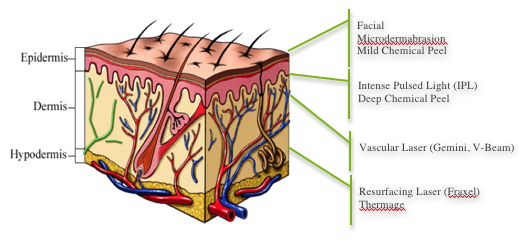
In recent years laser centres, skin clinics, medical spas and spas have sprouted up all over the Lower Mainland offering a multitude of skin treatments. Trying to figure out what concerns each treatment can address has become quite the task.
There are always limitations to what certain treatments can do, and not all businesses are above-board in sharing this information. Arming yourself with an understanding of the skin’s structure and what part of the skin each treatment reaches will help you assess what a specific treatment can do for you.
The Skin’s Layers
When comparing treatments and the skin concerns that they are alleged to treat, it is important to understand what layer of the skin that the treatment reaches: does it work with the epidermis, the superficial layer, or the dermis, the sublayers of skin that include collagen and elastin?
For example, microdermabrasion can be beneficial in refining your complexion (smoothing and buffing the skin) as it exfoliates the outer layer of skin. However, don’t expect it to work miracles with pigmentation. It may only have a modest effect on freckles and sun spots due to their origins in the basal layer of the epidermis (the bottom layer, closest to the dermis).
The more substantial treatments that reach the middle layer of the skin are the ones that provide more visible and long-lasting results. For example, since laser treatments penetrate into the dermis, they are able to address conditions like wrinkles, enlarged pores, pigmentation, sun damage and scarring.
How Lasers Treat the Skin
In recent years the choice of cosmetic laser treatments has also grown rapidly. The effectiveness of a laser procedure largely depends on upon utilizing the right wavelength of laser energy for the targeted tissue. For example, a vascular laser is able to treat facial redness, spider veins and other vascular issues by targeting hemoglobin in unwanted capillaries and blood vessels located in the dermis.
A resurfacing laser such as Fraxel reaches deep into the dermis and creates microscopic wounds in the skin, which triggers your body’s natural healing response system. This process stimulates your body’s remodeling of collagen and elastin in the dermis. It replaces the damaged tissue from the inside out, creating healthier, smoother, more youthful-looking skin.
Please contact us with any questions regarding the right skin treatment type for you.